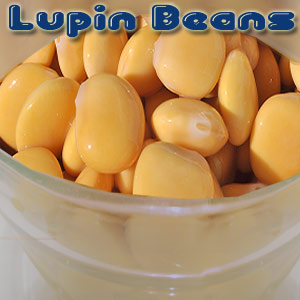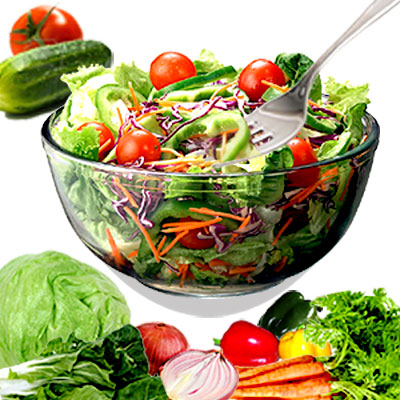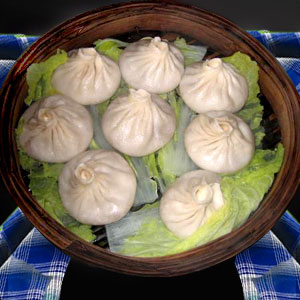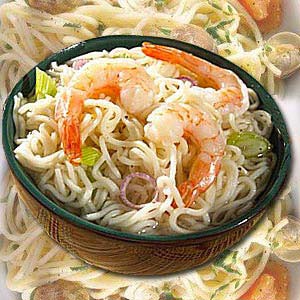Lupin Beans

One of the oldest cultivated foods, Lupin beans or Lupini beans are the seeds of the lupines plant. Rich in protein content, these beans are of Mediterranean origin. Lupini is indigenous to Italy and is cultivated widely here. It is yet to gain popularity all over the world.
Traditionally they were eaten throughout Southern Europe and Latin America along with beer. Due to the bitter taste and alkaloid content, a special 'debittering' treatment is essential before consuming lupin beans. This way, the toxic alkaloids are removed from the beans. Like olives, these legumes are otherwise quite bitter and inedible.
Lupin beans - composition and nutritional content
Although Lupin beans belong to the pea family and were primarily cultivated for their flowers, recent research has revealed yet another interesting aspect of Lupin beans in that - consuming Lupini beans for even a month can result in reducing blood pressure, lowering triglycerides and lowering cholesterol, and can result in weight reduction.
Round in shape, like a watermelon seed and light yellow in color, Lupin beans are large dried and similar to Fava beans. They are lowest in carbohydrates and have just 16 total carbs or 11.4 net carbs (total Carbs minus fiber and sugar alcohol) per cup. Once cooked, 1 cup Lupini beans provide 200 calories, 5 grams of fiber and 26 grams of protein. This is good news for weight watchers!
They can be taken as a light snack and also in pickled form and enjoyed as an antipasto, either cooked or chilled. Like pumpkin seeds, they are sometimes salted and prepared as a snack, perhaps a good alternative to popcorn.
High in nutrition, Lupin beans are a rich source of vitamin K, vitamin C, potassium and manganese. They are a great source of protein - the amount of protein in Lupin beans being as high as in soybeans (100 grams of Lupini beans contain 36 grams of protein). That is why, Lupin beans are vegans delight.
Using Lupin beans
Lupin beans can be purchased in canned form; as there is considerable effort to prepare them at home. They can be eaten with or without jacket (skins). For those wanting to prepare these beans at home, Lupin beans need to be soaked for several days in a number of changes of water in order to avoid anti cholinergic toxicity. They can also be prepared by only soaking them overnight in salt water.
Over time, the bitter alkaloids are released in the water. Therefore the longer you soak these beans, the better. After rinsing them thoroughly, they attain their optimum flavor. For two to three persons, one cup of dried beans, prior to soaking should be enough. A word of caution – those with allergy to peanut also tend to be allergic to Lupini beans.
Lupin can be eaten by biting a small tear in the skin and popping the inside into your mouth – but they can also be eaten with the skin on.
Rinse a bag of Lupin beans in cold water. Place a large saucepan and add a handful of salt in it. Cover with 2-3 inches of cold water. Bring the water to a boil. Now cover, reduce heat and simmer for about three hours. Strain and rinse well, and add another handful of salt again to the pan and add water to cover by a couple of inches. Place in the refrigerator. Repeat this for a fortnight or until the bitterness is completely gone. Once they are ready, store in a refrigerator in the same brine solution for many weeks. Whenever necessary, only the required amount of Lupin beans can be removed from the brine solution.
Cooking with Lupin beans
Other than eating it straight, Lupin beans can be used in a variety of ways. Combined cold with olive oil, garlic, a little shallot and sage, basil or thyme or parsley, they should make a delicious dish. In a three-bean or green salad, Lupin beans can be used. Warm them and mix with canned tomatoes.
Lupini beans can also be warmed up and tossed with shredded pork or chicken. It could be simply blended up in a food processor with some olive oil, garlic.
The low fat and carbohydrate nature of Lupini beans aid weight loss. Since the fiber curbs appetite, it offers a satisfied feeling during the day. Thus consumption of Lupin beans eliminates the tendency to gorge on other unhealthy snacks.
Lupin beans also ensure bowel health by acting as a probiotic and lessening the symptoms of constipation and other bowel problems.
Since these beans contain high amount of Arginine, an essential amino acid, they help in lowering blood sugar and cholesterol levels. Those with hypertension can benefit by adding Lupin beans to their menu.
Lupini beans are also a good antioxidant source. Regular consumption of Lupini beans can be linked to lowering the likelihood of developing various ailments such as cardiovascular problems, cancer and diabetes and neuro degenerative diseases.
Gout sufferers may be interested in Lupin beans as they do not produce purine acid during digestion. Diabetics will also benefit as they are very low on the glycemic index. Lupin flour is an alternative for those with celiac disease as it has no gluten. With a carbohydrate count, Lupini is a replacement for pasta, grains, breads and other legumes.
Top of the Page: Lupin Beans
Tags:#Lupin beans #Lupini beans
 Food and Nutrition Facts
Food and Nutrition Facts Chamomile
Parsnip Soup
Dim Sum
Gazpacho Soup
Whole Grain Cereal
Jicama Nutrition
Bok Choy Stir Fry
Chia Seeds Benefits
Teff Nutrition
Kaniwa
Flax Seed
Wheatgrass Benefits
Kelp Benefits
Types of Chili Peppers
Medicinal Benefits of Pomegranate
Arugula Leaves
Maca Root
Pitaya Fruit
Benefits of Celery
Leek
Asparagus Benefits
Oyster Stew
Oyster Mushroom
Lupin Beans
Quinoa
Freekeh
Extra Virgin Olive Oil
Dill Pickle
Sauerkraut
Fat Burning Foods
Nutrition Chart
Food Combining
Calorie Counter
calories ...
Non Alcoholic Beverage
Punch Recipes
Food Label Nutrition
Homemade Sausages
Cooking Steak
Eating on a Budget
Budget Friendly Recipes
Quick Recipes
 Healthy Packed Lunch
Healthy Packed Lunch Overnight Oats Recipes
Eggplant Casserole
Brunch Recipes
Burrito Recipes
Muffin Recipes
Cupcake Frosting
Apple Crisp
Stir Fry Cooking
Seafood Salad Recipe
Cooking Corn on the Cob
Finger Food Recipe
Sandwich Recipe
Bread Stuffing Recipes
Easy Chili Recipes
Picnic Recipes
Edible Mushroom Recipes
Mushroom Soup Recipes
Dip Recipe
Tapas Recipe
Corned Beef Recipe
Canned Salmon Recipe
Tilapia Recipes
Crumb Cake
Flourless Chocolate Cake
Regional Food
 Lasagna Recipe
Lasagna Recipe Peruvian Ceviche
Chinese Food Recipe
Vietnamese Food Recipe
Malaysian Food
Korean Food Recipe
Indian Curry Recipe
Edible Rice Paper
Mexican Food Recipe
Quesadilla
Guacamole Dip
Italian Food Recipe
Spanish Food Recipe
Kosher Food
Falafel Recipe
Tandoori Chicken
Noodles
Canape
Couscous
Meatloaf
Chowder
Gumbo Recipe
Crockpot Recipes
Moroccan Food
Healthy Food
Pre Workout Snack
Matcha Tea
Simple food Swaps to Lose Weight
Foods to Beat Stress
Foods to beat Insomnia
Bone Density Foods
Prebiotic Foods
Kefir Grains
Agave Nectar
Spicy Trail Mix
Pesto Sauce
Homemade Hummus
Crab Cake Sauce
Bamboo Shoots Nutrition
Lemon Grass Plant
Butter Beans Recipes
Loose Green Tea
Seaweed Nutrition
Healthy Food
Low Fat Granola Bar
Steel Cut Oatmeal
Fruit Pizza
Pizza Toppings
Green Smoothie
Healthy Meal Planning
Delicious Mealtime Recipes
Heart Healthy Fats
Healthy Heart Recipe
Healthy Dinner Recipe
Healthy Dessert Recipe
Healthy Fast Food
Healthy Kid Recipe
Probiotic Food
Diabetic Friendly Foods
Fruit Salad Recipe
Bread Pudding
Tofu Recipe
Oat Bran
Broccoli Salad
Avocado Recipe
Iron Rich Food
Brain Foods
Antioxidant Food
Natural Diuretic
Low Fat Cooking Tips
Rice Pilaf Recipe
Low fat Chicken Recipe
Food Tips

Sous Vide Cooking Technique
Natural Sugar Substitute
Stevia Sugar Substitute
Sunflower Seeds Nutrition
Bouquet Garni
Cake Decorating Tips
High Satiety Foods
Thanksgiving Dinner
Safe Food Storage
Frozen Food Storage Tips
Cold Storage Food Tips
Leftover Recipe
Food Pyramid
Dairy Free Food
Microwave Cooking
Food Intolerance
Homemade Ice Cream
Apple Cider Vinegar
Benefits of Honey
Beverage Cooler
Food Poisoning Symptom
Food Allergy Symptom
Food Addiction
Top of the Page: Lupin Beans
Popularity Index: 102,822

